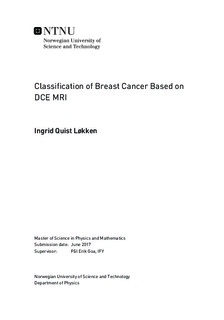Classification of Breast Cancer Based on DCE MRI
Master thesis
Permanent lenke
http://hdl.handle.net/11250/2462633Utgivelsesdato
2017Metadata
Vis full innførselSamlinger
- Institutt for fysikk [2686]
Sammendrag
This master thesis is a part of a project at the MR group at the department of physics at NTNU. The aim of MR group is to make a model which is able to classify the subtype of breast tumours. In this master thesis the focus has been on dynamic contrast enhanced images
The first part of this master thesis consist of trying out different methods for motion correcting images. The reason for this was some unsatisfactory results of the motion correction done in the specialisation project during the fall of 2016. Some of the patients had images with remaining motion after the motion correction algorithm had been applied. The motion correction was now done using normalised cross correlation with 3, 6, and 9 degrees of freedom, and then using another similarity function, namely normalised mutual information. The result was that for some patients increasing the number of degrees of freedom from 3 to 6 would slightly improve the results of the motion correction.
The next part was to coregister the images to a reference image. This was done to make the future combination of images from different MRI modalities easier. The reference image chosen was a T2 MRI image, because this is taken for all patients for anatomical reasons. The method used for coregistration was a software called CMTK, the same we used for motion correction. The similarity function used was normalised cross correlation with 3 degrees of freedom.
Then regions of interest was found for different parameters, we chose to try to classify air, breast tissue in general, benign tumours and malignant tumours. ROIs was found for the included patients, and the pixel values implemented in a matrix. Then a SVM classifier was used on the matrix, to see if it was possible to classify different kinds of pixels in a test set. When only including benign tumours, not malignant, the SVM classifier classified 99.7 % of the pixels correctly. When including malignant tumours the correctly classified rate dropped slightly to 97.4%.
